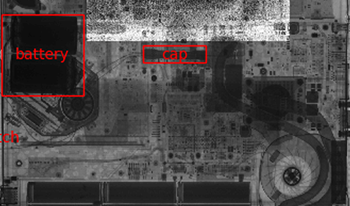
Portable X-ray imaging systems are routinely used by bomb squads throughout the world to image the contents of suspicious packages and explosive devices. The images are used by bomb technicians to determine whether or not packages contain explosive devices or device components. In events of positive detection, the images are also used to understand device design and to devise countermeasures. The quality of the images is considered to be of primary importance by users and manufacturers of these systems, since it affects the ability of the users to analyze the images and to detect potential threats. As such, there exist national standards that set minimum acceptable image-quality levels for the performance of these imaging systems. An implicit assumption is that better image quality leads to better user identification of components in explosive devices and, therefore, better informed plans to render them safe. However, there is no previously published experimental work investigating this.
Toward advancing progress in this direction, the authors developed the new NIST-LIVE X-ray improvised explosive device (IED) image-quality database. The database consists of: a set of pristine X-ray images of IEDs and benign objects; a larger set of distorted images of varying quality of the same objects; ground-truth IED component labels for all images; and human task-performance results locating and identifying the IED components. More than 40 trained U.S. bomb technicians were recruited to generate the human task-performance data. They use the database to show that identification probabilities for IED components are strongly correlated with image quality. They also show how the results relate to the image-quality metrics described in the current U.S. national standard for these systems, and how their results can be used to inform the development of baseline performance requirements. They expect these results to directly affect future revisions of the standard.
Jack L. Glover, Praful Gupta, Nicholas G. Paulter Jr., Alan C. Bovik, "Study of Bomb Technician Threat Identification Performance on Degraded X-ray Images" in Journal of Perceptual Imaging, 2021, pp 010502-1 - 010502-13, https://doi.org/10.2352/J.Percept.Imaging.2021.4.1.010502
| IED type | Switch/activator | Detonator/initiator | Charge/explosive | Power source |
|---|---|---|---|---|
| Suitcase IED | Cell phone trigger and arming switch. Once armed, the device can be remotely activated by calling the cell phone. | Commercial blasting cap and cast-TNT booster | ANFO simulant | 6 V Lantern battery |
| Photocell activated pipe bomb | Photocell and arming switch. Once armed, the device is activated by exposure of circuit to light (e.g., by opening the bag or box containing the IED). | Squib | Metal pipe bomb | 2 × D batteries |
| Anti-probe IED | Two layers of Al foil separated by paper. Activated by physical entry attempt which causes foil layers to touch and complete circuit. | Commercial blasting cap | C4 simulant | 2 × D batteries |
| Chemical IED | Microswitch to arm. | Commercial blasting cap | Liquid chemical simulants | 2 × D batteries |
| Laundry detergent PVC pipe IED | Ball tilt switch and arming switch. Once armed, the device is activated by ball switch which is triggered by physical movement of IED. | Squib | Smokeless powder in PVC pipe | 2 × 9 V batteries |
| Steel plate IED | Timer and arming switch. Once armed, the device is activated by an analog timer. | Squib | Black powder simulant | 1 × 9 V battery |
| Pressure cooker IED | Radio-controlled servo switch (remote activated). | Squib | Black powder simulant | 4 × AA batteries |
| N42.55 metric | Other variable | Y ID3 | Y ID4 |
|---|---|---|---|
| (lower range, upper range) | (lower range, upper range) | ||
| NEQ at 1 cycles/mm | None | 1569.15 | 16533.82 |
| (961.70, 3467.54) | (6770.27, 75290.63) | ||
| Organic material detection | None | 1.28 | 2.29 |
| (1.05, 1.66) | (1.87, 3.09) | ||
| Dynamic range | σb | 23.22 | 59.54 |
| (16.07, 33.03) | (42.77, 91.50) | ||
| MTF20 | k (the noise parameter) | 0.53 | 1.65 |
| (0.15, 0.84) | (1.29, 1.94) |
 Find this author on Google Scholar
Find this author on Google Scholar Find this author on PubMed
Find this author on PubMed